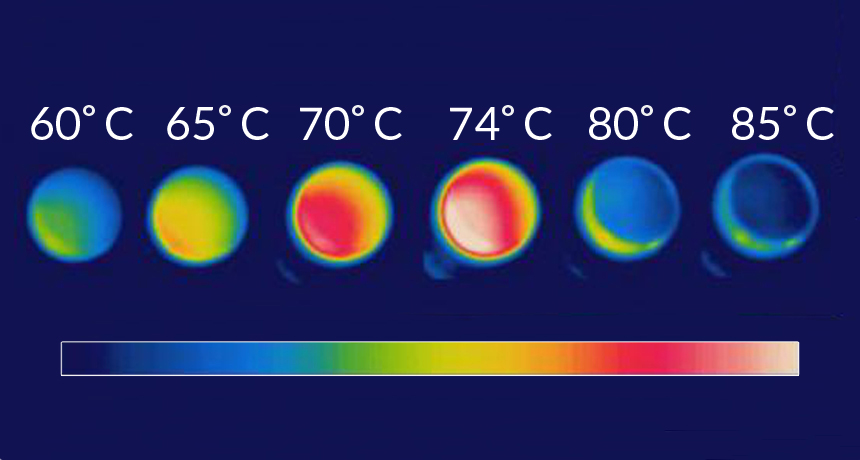Looking unbelievably cool
A material looks like it's cooling off even as its temperature rises

Hot has never looked so cool. Even as a sample of vanadium oxide heated up (left to right), the infrared light it emitted made the sample appear to cool down. Red normally represents hot materials and blue cold.
COURTESY OF M. KATS/HARVARD UNIV
The hotter it gets, the more it glows. This rule applies to stovetops and light bulbs alike. But it doesn’t hold true for all everything. Scientists report finding a rule-breaker — one that appears to cool down even as its temperature climbs.
A material like this could be used to build objects that can fool infrared cameras, the kind that see heat, rather than visible light. It may also help scientists design heating and cooling systems that will use less energy. The new study was published Oct. 21 in the scientific journal Physical Review X.
Not all materials respond to changing temperatures in the same way. As their temperatures rise or fall, some substances change the way they respond to light or electricity. That’s true for vanadium dioxide. At temperatures below 70 degrees Celsius (158 degrees Fahrenheit), this material acts like an insulator. That means electricity can’t easily pass through it.
Above 70 °C, things change. The compound suddenly becomes a conductor. Electricity now readily passed through it.
Scientists don’t know exactly why vanadium dioxide does this. But its behavior gave physicist Mikhail Kats at Harvard University an idea. He wondered if that switch in the compound’s electrical properties would also change how much it glows.
So he and his colleagues put a thin slice of the material on a wafer made of sapphire. Then they started heating it. An infrared camera recorded the results. Unlike the human eye, this camera can see infrared light, a type of radiation.
As the material’s temperature climbed from 60 to 74 °C, the camera showed it gave off increasing amounts of radiation. That means it glowed brighter and brighter. Then something strange happened. Even as the compound’s temperature continued to rise, its glow began to diminish.
“We saw this really dramatic effect,” Kats told Science News. “You have an object that at 90 °C looks the same as at 50 °C.”
This means the material hides its true temperature, by appearing cooler as it continues to warm. Scientists don’t yet know how the material rearranges its structure to pull off this trick. Kats hopes to find out.
“It’s a very clever paper,” Daniel Wasserman told Science News. An electrical engineer at the University of Illinois at Urbana-Champaign, he did not work on the new study. The new finding certainly “opens the door to some really interesting physics,” he concludes.
POWER WORDS
conductor A material through which an electrical current can flow easily.
engineering The field of research that uses math and science to solve practical problems.
infrared light A type of electromagnetic radiation invisible to the human eye. The name incorporates a Latin term and means “below red.” Infrared light has wavelengths longer than those visible to humans. Other invisible wavelengths include X-rays, radio waves and microwaves.
insulator A substance or device that does not readily conduct electricity.
radiation Energy, emitted by a source, that travels through space in waves or as moving subatomic particles. Examples include visible light, infrared energy and microwaves.







